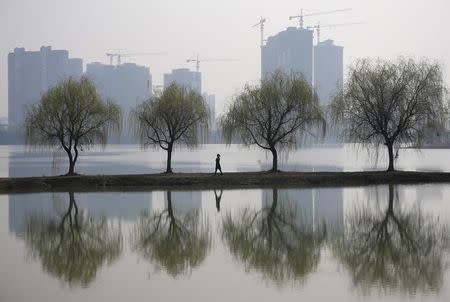Despite deforestation, the world is getting greener - scientists
By Alisa Tang BANGKOK (Thomson Reuters Foundation) - The world's vegetation has expanded, adding nearly 4 billion tonnes of carbon to plants above ground in the decade since 2003, thanks to tree-planting in China, forest regrowth in former Soviet states and more lush savannas due to higher rainfall. Scientists analysed 20 years of satellite data and found the increase in carbon, despite ongoing large-scale tropical deforestation in Brazil and Indonesia, according to research published on Monday in Nature Climate Change. Carbon flows between the world's oceans, air and land. It is present in the atmosphere primarily as carbon dioxide (CO2) - the main climate-changing gas - and stored as carbon in trees. Through photosynthesis, trees convert carbon dioxide into the food they need to grow, locking the carbon in their wood. The 4-billion-tonne increase is minuscule compared to the 60 billion tonnes of carbon released into the atmosphere by fossil fuel burning and cement production over the same period, said Yi Liu, the study's lead author and a scientist at the University of New South Wales. "From this research, we can see these plants can help absorb some carbon dioxide, but there's still a lot of carbon dioxide staying in the atmosphere," Liu said by telephone from Sydney. "If we want to stabilise the current level of carbon dioxide in the atmosphere - and avoid the consequent impacts - it still requires us to reduce fossil fuel emissions." Liu, who specialises in observing the water cycle including rainfall and soil moisture, used a new technique of collecting satellite data on radio frequency radiation naturally emitted by the Earth to calculate the amount of vegetation in a given area. Before, scientists measured vegetation through satellite images and other techniques, looking at canopy greenness and plant height, he said. Liu had expected to find increased forests in China, which has had tree-planting projects for two to three decades, as well as on abandoned farmland in former Soviet countries. But he was surprised to discover the large expansion in vegetation due to higher rainfall on tropical savannas and shrublands in Australia, Africa and South America. These fragile gains may be easily lost, as weather patterns shift with climate change, he warned. "Savannas and shrublands are vulnerable to rainfall – one year can be very wet, and more carbon will be fixed in plants, but the next year can be very dry, and then we will lose the carbon fixed in previous years," Liu explained. Louis Verchot, a research director at the Indonesia-based Center for International Forestry Research, said Liu's findings were "by and large what we would expect in the warmer and wetter world that results from climate change". "As ice and permafrost melt, they are being replaced by vegetation, and the tree line is moving north as the Arctic warms," he said by email. Vegetation growth is also expected to increase due to rising CO2 in the atmosphere, known as the "CO2 fertilisation effect". Verchot said the value of Liu's study was that it put a number on the contribution of vegetation to moderating greenhouse gas accumulation in the atmosphere. "Hopefully this will lead to greater efforts to stop tropical forest loss and to promote sustainable use of ecosystems in ways that preserve enough of the carbon absorption function as we continue to pump CO2 into the atmosphere through fossil fuel burning," Verchot added. (Reporting by Alisa Tang, editing by Megan Rowling)



